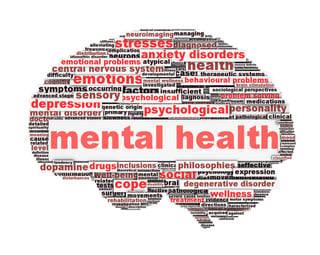Let’s Remove the Mental Health Stigma
Bryan Robertson | September 13, 2016 | Depression, Anxiety, Chronic Conditions
 People with mental health issues are some of the most stigmatized, marginalized and disadvantaged members in our society. The negative connotations and false information related with mental illness is as harmful as the disease itself.
People with mental health issues are some of the most stigmatized, marginalized and disadvantaged members in our society. The negative connotations and false information related with mental illness is as harmful as the disease itself.
Persons with mental illnesses are commonly described as dangerous, scary, lazy, or viewed with pity (Corrigan & Penn 1999). Stigma has far reaching effects on an individual that include lack of employment opportunities, housing limitations, and barriers to obtaining and receiving treatment services (Alexander & Link, 2003).
In addition, it has negative consequences on an individual’s self-esteem and motivation to seek out mental health care (Corrigan, Druss & Perlick, 2014). Mitigating stigma related to people with mental illness is a difficult mission. In order to change attitudes, initiatives at the structural and individual level can be implemented to increase knowledge and acceptance of individuals with psychiatric illness.
The Mental Illness Epidemic
Approximately 1 in 5 adults, or 18.5% of the population, experience mental illness in a given year (Mental Health Statistics You Need To Know). Over 10 million adults, or 4.2%, experience a serious mental illness that substantially interferes or limits their major life activities. For children, the estimate is around 13%. (NAMI). Additional significant statistics from NAMI that highlight the prevalence of mental illness include:
- 18.1% of adults in the U.S. experienced an anxiety disorder such as posttraumatic stress disorder, obsessive-compulsive disorder and specific phobias
- Disorders such as depression, dysthymic disorder, and bipolar disorder, are the third most common cause of hospitalization in the U.S. for both youth and adults
- Suicide is the 10th leading cause of death in the U.S.
- Over 37% of students with a mental health condition age 14 and older in special education drop out of school
Although a large majority of the population experiences mental illness, research suggests people hold negative attitudes and stereotypes towards those with mental illnesses (Rusch, Angermeyer & Corrigan, 2005). Because mental illness has been historically viewed as a character flaw, these individuals are viewed as outcasts and judged by society.
Persons with mental illnesses are viewed more harshly than other disability groups. Thus, there is more public disapproval of persons with psychiatric disabilities more than those with physical illnesses (Weiner, Perry & Magnusson,1988).
Marginalized and Misunderstood
The psychiatrically ill are perceived as being personally responsibility for their illness, violent, dangerous, unpredictable, or incompetent (Corrigan, 2002). One study found that over 45% of participants considered people with depression to be “unpredictable”. Over 20% of participants reported that people with depression were “dangerous” (Wang & Lai, 2008).
In a study that evaluated stigma experiences of adolescents, 62% of participants experienced stigmatization in relationships with peers, which was a factor in friendship losses. 46% of adolescents indicated experiencing stigmatization by family members, which was described as “unwarranted assumptions, distrust, avoidance, pity, and gossip” About one third (35%) of adolescents reported stigma from school staff, who expressed fear, dislike, avoidance, and under-estimation of their abilities.
Fortunately, 22% reported "different" treatment by school staff, but this treatment was interpreted as positive and supportive (Moses, 2010).
Stigma in Healthcare
 Medical professionals and mental health practitioners are also believed to hold stigmatizing beliefs. Stigma can develop in those in the medical field entrusted with supporting people with a mental illness. Evidence suggests that medical professionals hold the same stereotypes against the mentally ill as the general public (Corrigan, 2002).
Medical professionals and mental health practitioners are also believed to hold stigmatizing beliefs. Stigma can develop in those in the medical field entrusted with supporting people with a mental illness. Evidence suggests that medical professionals hold the same stereotypes against the mentally ill as the general public (Corrigan, 2002).
Surveyed medical professionals were found to report “fear” as the most prevalent emotion regarding this population. They also indicated “dislike, neglect, and anger”(Penn & Martin, 1998). The beliefs held by professionals can perpetuate stigma by creating more labels that influence a client’s behaviors and symptoms.
It is recommended that a medical professional undergo sensitivity and cultural competency training, as well as exposure to diverse patterns of behavior to mitigate stigmatizing attitudes (Overton & Medina, 2008).
Internalizing Society's Stigma
Many people with mental health issues recognize and internalize society’s stigma against mental illness. When people experience rejection and failure due to social stigma, such as social isolation or discrimination, they may experience lowered self-esteem and self-efficacy. This could lead to an internalization of society’s stigma, or self-stigmatization, where the individual undergo an evaluation of him or herself. This judgment of themselves leads to a decrease in their self-esteem.
A person might have judgmental thoughts such as, “I am not acceptable” or “I don’t fit in with society” as a reaction to stigmatizing experiences. They might also think of themselves as unable to recover, undeserving of care, dangerous, or responsible for their illnesses (Watson, Corrigan, Larson & Sells, 2007).
Further, as people experience symptoms of their mental health conditions such as depression or anxiety, some people might separate from, avoid, or suppress their symptoms or feelings. This may also help explain why many individuals with mental illness do not receive the mental health services they need as stigma is associated with significant barriers to mental health care.
When individuals with psychological disorders internalize the notion that they cannot recover, and want to avoid further discrimination that they are “mentally ill”, they are less likely to seek out treatment (Corrigan, Druss & Perlick, 2014). They might develop a “why try” attitude and become less motivated to seek out mental health services.
Stigma and Somatic Symptoms
As a self-fulfilling prophecy, it is not uncommon for people who experience such stigma to also experience more somatic symptoms. It is more socially acceptable to complain of stomach aches and fatigue than one’s psychiatric problems (Wolport, 2001).
Anticipation of negative responses from family members, loved ones or employers can also result in people with mental illness withdrawing from or limiting their social or occupational functioning (Alexander & Link, 2003).
Consider the following example of a person suffering from mental illness stigma. John is 28 years old and has schizophrenia. He has been hospitalized several times when his symptoms became unmanageable. For two years, he has been symptom-free, living independently, and working in a real estate office and enjoying an active social life.
Recently, he had a relapse and was hospitalized. It took him two months to recover and be ready to work again. However, after his recovery, he realized that his management of symptoms would not suffice. His employer told him that he would be let go because he could have a dangerous outburst in the office due to his mental illness.
In addition, his family felt that it was too risky for him to keep living on his own with the added stress of unemployment. They convinced him to move home. He now lives far away from his friends. Thus, despite a good recovery, the public stigma of John’s schizophrenia has impacted his occupational prospects, independence, and relationships.
Mental Illness and Gainful Employment
 Psychiatric prejudice and discrimination has been identified as a contributing factor to limiting gainful employment of this population. Negative attitudes and beliefs towards mental illness is found to restrict employment opportunities by contributing to long periods of unemployment, restricting access to higher paying jobs, and job termination when the illness is disclosed.
Psychiatric prejudice and discrimination has been identified as a contributing factor to limiting gainful employment of this population. Negative attitudes and beliefs towards mental illness is found to restrict employment opportunities by contributing to long periods of unemployment, restricting access to higher paying jobs, and job termination when the illness is disclosed.
They also encounter negative comments and behaviors by co-workers and employers (Russinova, Griffin, Bloch, Wewiorski & Rosoklija, 2011). Evidence suggests that once people have been labeled “mentally ill”, they are more likely to be underemployed and to earn less than people with the same psychiatric difficulties but who have not been identified as having them (Alexander & Link, 2003). Thus, there is a need to address workplace prejudice and discrimination to promote workplace integration of individuals with psychiatric disabilities.
Mental illness and substance abuse indirectly costs employers between 80 to 100 billion dollars annually (Partnership for Workplace Mental Health, 2006). Evidence suggests that when employers invest in their employee’s mental health, there is a decrease in absenteeism and disability. Mental wellness initiatives in the workplace can also increase productivity, engagement and creativity (Seth, 2016).
An important aspect of these initiatives is to transform the way employers and employees think about mental illness in the workplace. This is enabled through the creation of a workplace that views the employee holistically- it provides visibility, safety, support and access for mental health support (Holmes, 2016).
Finally, the transformation of the contemporary workplace can occur through the implementation of policies of zero tolerance of prejudice and discrimination toward people with mental or physical disabilities (Russinova, Griffin, Bloch, Wewiorski & Rosoklija, 2011). With the addition of these policies, workplace culture can help erase stigma and encourage employees to seek support.
What can I do?
Everyone can play an important role in reducing stigma. There are several ways that those with and without mental illness can be a change agent: protest, education and contact (Corrigan & Penn 1999). Protesting stigma involves addressing the inequality of stigma and appeals for people to stop thinking or behaving in stigmatizing ways.
Education is also important. Whether you are an individual with mental illness, or a family member of a person with mental illness, providing accurate information can replace wrong stereotypes with correct facts.
Finally, talking about mental health can make a big difference. Making social contact with people with and without mental health problems is a powerful approach to breaking down taboos around the issue. The intent is that, as mental illness becomes demystified, people will better understand the early signs of mental illness and feel able to get help for themselves or their friends (Corrigan & Penn, 1999).
The unfortunate reality for those with mental illness is that living within a community does not necessarily mean that they are considered part of the community (Hocking, 2003). By engaging in an honest and meaningful dialogue about mental health, the associated stigma and discrimination can be reduced.

Join the Conversation